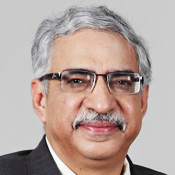 |
|
|
||||
BUDGET REACTIONS 2013-14
IRS officers under tremendous pressure M. Rama Rao, President, IRS (C&CE) Association One Time Voluntary Disclosure for Service Providers will add to the work pressure of already burdened tax officers. Our Association demanded adding man power to ST: in the short run, by hiring retired junior officers. No action on this front so far. We have explained the RS during our meetings how shortage of staff is resulting in huge leakage of ST revenue. We explained this with cost benefit analysis. Our suggestion has not been acted upon so far. Targets on Revenue and Fiscal Deficits could be achieved without hiking rates by just augmenting the tax machinery with resources. This would have helped economy better. Without the resources, the IRSOfficers are under tremendous pressure to deliver. This has compromised our working conditions. |
||
 |
R M Malla, Chairman & Managing Director, IDBI Bank The Union Budget for 2013-14 has been framed in a situation of considerable economic difficulty. Overall economic growth has been subdued on the back of weak performance across the three sectors, i.e. agriculture, industry and services. As compared to average growth rate of 8.0% plus posted in the last decade, the Indian economy is projected to grow at only 5.0% during 2012-13. At the same time, the persistently high inflation rates prompted the Reserve Bank of India (RBI) to adopt a hawkish monetary policy stance, which resulted in the longest monetary policy tightening by the RBI. The high interest rate environment has impinged upon the investment appetite in the economy leading to a further slowdown in the industrial sector. Further, the twin deficits - Current Account Deficit (CAD) and Fiscal Deficit (FD) - continue to pose a threat to the rapid recovery of the economy to a high growth trajectory unless contained at the earliest. Union Budget 2013-14 Initiatives: The key focus of the Union Budget has been to bring back the Indian economy to the high growth path. At the same time, the focus has been on inclusive and sustainable development. The Union Budget 2013-14 was a combination of welfare oriented and fiscal prudence measures. It is heartening to note that the FM has introduced various pro-growth measures aimed at stimulating the investor sentiments and business confidence. To boost the ailing industrial sector, the FM has proposed Investment Allowance of 15% to companies on investment in plant & machinery over Rs.1 billion. In cognizance of the importance of the infrastructure sector, the FM has rightly focussed on enhancing the flow of funds into the sector, as also ensuring revival in the subdued capital investment climate. The Government has been able to contain the fiscal deficit at 5.2% of GDP as against the revised target of 5.3% for the current fiscal. In line with the concern over the twin deficits, the Government has aimed to contain the Fiscal Deficit at 4.8% in FY 2013-14 by rationalizing its expenditure plans and bridge the Current Account Deficit by encouraging foreign capital inflows. The measures announced in the Budget towards narrowing the CAD include calibration of the foreign investment definition into FII and FDI investment, simplification of procedures for FIIs investment, permission for foreign investment in currency derivatives, dedicated debt exchange, etc. The expected easing in CAD situation in response to the reform measures will reduce the burden on foreign exchange reserves and will arrest the Rupee depreciation. On the agricultural front, the Government has announced measures to enhance the productivity of the agricultural sector which will lead to a reduction in food inflation in addition to ensuring food security for the citizens of the country. The tax initiatives include a surcharge of 10% on rich taxpayers. The FM has further specified that the surcharge has been introduced for a period of one year keeping in mind the extraordinary circumstances. As a breather to the masses, the tax bracket has been enhanced along with a provision of tax credit for citizens in the lowest tax bracket. With the escalating cost of housing, the Government has announced additional deduction of interest up to Rs. 1 lakh for first home loan taken up to Rs. 25 lakh. While the Securities Transaction Tax (STT) has been reduced to 0.01%, the Government has introduced Commodities Transaction Tax (CTT) on non-agriculture futures contracts at 0.1% in a bid to widen its tax base. In response to the low real returns witnessed in the last couple of years, the Government plans to introduce Inflation Indexed Bonds (IIBs) in consultation with the RBI to protect erosion in the valuation of the savings as a result of high inflation. The enhanced tax slabs as well as the introduction of various financial instruments for the common man would not only benefit the masses but also translate into a faster economic progress of the country as a major proportion of the savings get channelized into productive investment avenues. With the implementation date of BASEL III approaching fast, the announcement of capital infusion in the Public Sector Banks (PSBs) will take some pressure off the banks to raise capital to meet regulatory requirements. In line with the gender-sensitive economics, the FM has also announced the setting up of an All Women’s Bank as an innovative measure to cater to the financial needs of women and enhance the participation of women in the financial sector. Financial Inclusion continues to be the focal point of the Budget in a bid to ensure inclusive and sustainable growth. Ultimately, the Union Budget is a statement of intent about the path that the Government proposes to traverse in order to rejuvenate and sustain economic growth impulses. The intentions underpinning the Budget proposals – such as the need to attain fiscal consolidation, widen the tax base, provide impetus to economic growth, ensure inclusive economic development and rein in wasteful expenditures & spending – are indeed commendable. The Hon’ble Union Finance Minister – credited with the Dream Budget of FY 1997-98 – has balanced seemingly irreconcilable objectives with considerable finesse while framing the Budget proposals, by supporting growth and, at the same time, making expenditure more effective and ensuring fiscal discipline. Now, it is up to the Government to ensure that the initiatives outlined in the Budget are effectively operationalised so that out great nation can regain the high growth path. |
|
 |
Gautam Adani, Chairman, Adani Group Prudent Budget: Fine Balance between Austerity and Profligacy with Infra-push It is a prudent growth oriented budget with a special focus on improving Healthcare, Education, Livelihood and Infrastructure sectors. I think the political compulsions made the FM decide that the best way is to play it safe, economics calls for austerity while the politics demands profligacy – in nut shell it is fine balance between populist measures and hard-nosed reforms. |
Deepali Bhargava, Chief India Economist, Espirito Santo Securities Fiscal consolidation: The finance minister delivers a budget broadly in line with what he had already prepared the market for. Fiscal deficit/GDP is expected to fall to 5.2% in FY13 and 4.8% in FY14. But any concrete measures to arrest the fall in infrastructure investment; and promote increase in financial savings have come as a disappointment. Overall consolidation is once again based on one-off asset sales. No mention of GST and DTC roll-out: No roadmap for GST has been issued. The FM has budgeted a sum of INR 90 bn towards the first installment of the balance of CST compensation. The key issues - constitutional amendment; need for State Governments and the Central Government to pass a GST law that will be drafted by the State Finance Ministers and the GST Council, still remain. Nothing concrete on DTC was said. Measures to boost financial savings not enough: The income limit on Rajiv Gandhi Equity Savings Scheme has been enhanced to from `INR 10 lacs to INR 12 lacs, to include investment for three successive years. We think the impact of the enhancement may still be limited as its restricted to only new investors. Other measures like hike in investment limit in infrastructure bonds for individuals or promoting investment in deposits is missing. There is also absence of any schemes which could have provided inflation-linked returns Rationalization of Subsidies: There’s a commitment to reduce subsidies to 2% of GDP in FY14, which is achievable if diesel subsidies are eventually eliminated. Increase in fertilizer subsidy is disappointing. Impact on investment: The budget doesn’t give any respite from high government borrowing and private sector crowding out. 89% of the fiscal deficit is budgeted to be funded by market borrowing. Net market borrowing has gone up from INR 4.67 tn in FY13 to INR 4.84 tn in FY14 (against expectations of INR 4.7 tn). The positive is lower reliance on short-term borrowings (INR 198 bn in FY14 vs. INR 1.2 tn in FY12)
|
Construction Federation of India (CFI) "Positive" Budget for Road & Infrastructure: CFI The Construction Federation of India (CFI) has termed the Budget 2013-14 "positive" for the road and infrastructure sector in view of announcements of new regulatory authority for road sector coupled with 3000 km roads projects in 2013-14 and focus on infrastructure debt funds. |
 |
Dr. R. Venkata Rao THE Budget has been like ChidambaraRahasyam. It sends a clear message that the Middle class should be prepared to make sacrifices with enlightened self-interest. Focus on Mid day Meals,Food Security and MNREGA is praiseworthy. 10 percent surcharge for super-rich is judicious. Steps for empowerment of women through emancipation, let us pray,will not flatter to deceive. "A difficult task performed well"-full marks to the Finance Minister for unravelling ChidambaraRahasyam judiciously. |
 |
B V Kumar, Former Member CBEC Touching Budget Speech The speech of the Finance Minister was eloquent, touching and some times moving, when he refers to the girl child, young women aspiring to shape their career and life, with dignity, women and the poor. As Sanjay Baru said that the task before the FM was to solve the following equations: The Revenue and the expenditure equation. The Savings and Investment equation. The Exports and Imports equation. The Economic Growth combined with inclusive development and Employment equation. The question is whether the FM succeeded in minimizing the mis-match and reducing the gap between the two parts of the equations in the Budget Exercise. While he appears to have not tinkered much with the Indirect taxes (Subject to verification of the fine print / Notifications), he mentioned in his speech that he would provide maximum incentives to units that would be set up for manufacture of Semi conductor devices / wafers. This is a move in the right direction and I hope this would be extended for setting up units for the manufacture of other high technology goods. He also mentioned that he would simplify and rationalize the tax structure. He has provided funds for a numbers of development schemes, particularly for infrastructure, core industries such as coal, education, health, transport, etc.,. It is hoped that he will be able to implement these programs. |